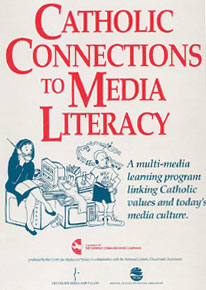Who Tells the Stories?: Catholic Media Literacy Curriculum Published
|
NOTE: This curriculum, published in 1993, has been discontinued and is no longer available. Still relevant portions of these materials are available on this website. |
Multimedia program to be used in schools and parishes nationwide
LOS ANGELES, CA, September, 1993 — Reclaiming the story-telling and value-assigning roles that media, especially television, have taken over from families, schools and religion is the goal of a unique media literacy project developed this fall by The Catholic Communication Campaign for use in Catholic classrooms, parishes and homes.
The new multimedia learning program, called Catholic Connections to Media Literacy, was developed to answer the urgent need for a new educational approach to the issues of mass media in society today.
"Media literacy helps us decode the data," said Sister Elizabeth Thoman, CHM, director of the Los Angeles-based Center for Media and Values and executive producer of the project. "We need to process the publications, translate the television, make sense of the music videos."
"Those who tell the stories shape the values," she added. "Media literacy provides a way to empower teachers, leaders and parents to take an active role in challenging the stories and therefore the influence that media, especially TV, can have on our attitudes and behavior."
The Catholic Connections to Media Literacy package offers "user-friendly" resources including a leader's guide with 15 basic lesson plans and handout masters, a sourcebook for parish and family-related applications, a 12-page directory listing over 150 available teaching resources, copies of a special issue of Media&Values magazine providing background on media's impact, and — to tie the program together — a 20 minute motivational video.
A project of The Catholic Communication Campaign, Catholic Connections to Media Literacy was produced by the Center for Media and Values in collaboration with the National Catholic Educational Association.
According to Ramon Rodriguez, national director of The Catholic Communication Campaign, "we can no longer ignore the impact of media in our lives. We need to be able to analyze critically how we interact as people of faith in a culture influenced more and more by commercial media."
Catholic Connections provides the "starter tools and background" for introducing media literacy activities not only in classrooms but in youth and young adult programs, religious education, marriage preparation and faith groups.
Although widespread in Europe, England, Australia and Canada, media literacy programs have not been developed to date in private or public schools in the U.S. According to Thoman, Catholic Connections is the first comprehensive media literacy package developed for use in the United States.
Sister Regina Haney, OSF, of the National Catholic Educational Association, described the multimedia learning program as "an excellent way of learning to think critically and reflectively about the world we live in today."
"It's just the beginning of a targeted program of media literacy for the 1990's," she added. "Our goal is to have every school and parish participating by the end of the decade."
The Catholic Communication Campaign was established by the U.S. Catholic bishops in 1978. Funded by annual parish collection, the Campaign, in turn, provides funding for network television specials, quality films, projects in the Catholic press and other values-centered media projects that have national impact.
Founded in 1989 as an expansion of Media&Values magazine, the Centre for Media and Values is pioneering the field of media literacy education in the United States. The National Catholic Educational Association represents more than 200,000 educators serving 7.6 million students in Catholic education at all levels.
Note: Catholic Connections to Media Literacy, published in 1993, is no longer available for purchase. Still-relevant sections are posted on this website.



